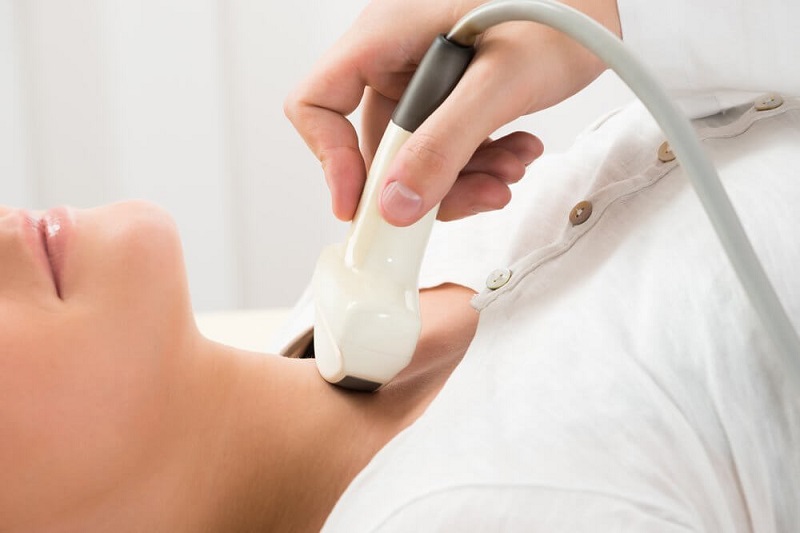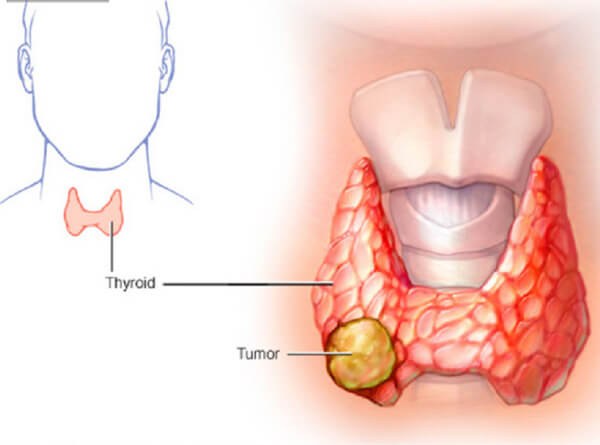Ultrasound of the thyroid disease helps doctors quickly detect abnormalities in the thyroid gland. This is a common and fast test today, through sound waves to create images of the thyroid gland to have more accurate conclusions will be obtained if the patient is suspected of having gland-related diseases.
But there are many patients who are still concerned about whether using an ultrasound might cause any harm? How does the ultrasound process …? This article helps you better understand issues related to detecting thyroid disease by ultrasound.
Learn More about Thyroid and Thyroid Pathology

To answer the question of how important ultrasound is for thyroid disease, we should first know what the thyroid is and what are common thyroid diseases.
The thyroid gland is an important organ on par with the vertebra C5 – T1, located in the front of the neck. The thyroid gland is shaped like a butterfly, with an average weight of about 20-25 grams, consisting of 2 lobes of the left and right lobes connected through the strait.
Although the thyroid is a small under-noticed organ, it is extremely important for maintaining the stability of other organs in the body. The thyroid is the place to regulate two hormones T3 (Triiodothyronine) and T4 (Thyroxine) to help normal metabolism, maintain calcium concentration in the blood at 1%, stimulate the activity of the nervous and cardiovascular system.
When the thyroid has an abnormal problem, an irregular increase or decrease in the number of hormones will lead to thyroid problems as follows:
- Hypothyroidism is a condition in which the thyroid gland is ineffective, reducing the secretion of hormones that make the body's metabolic process abnormal, affecting the health of the patient.
- Congenital hypothyroidism occurs when the thyroid gland does not produce enough hormones for the body's vital activities. A disease occurring in newborns should be treated early to avoid seriously affecting the child's development.
- Hyperthyroidism is an increase in hormone secretion by the thyroid gland, speeding up metabolism, causing the body to not adapt in time, causing health problems for patients.
- Basedow disease is an autoimmune disease that is highly common but causes many dangerous symptoms and complications for the sufferer. Up to 80% of people with hyperthyroidism will have Basedow disease.
- Thyroid cancer is a malignant disease that causes the thyroid to swell and the glands in the neck area make the body fall into a state of fatigue, etc. Complications easily occur if not treated promptly.
What is Thyroid Ultrasound?

Thyroid ultrasound is a method through sound waves, from which doctors will diagnose thyroid disease from high-resolution ultrasound images to clearly observe every detail about the properties and current features and structure of the surrounding thyroid.
During a routine physical exam, an ultrasound of the thyroid gland is also a part to check for abnormalities in the body. This is a completely painless method that is safe for the patient. And at present, there are no contraindications for a thyroid ultrasound.
What Is The Purpose of A Thyroid Ultrasound?

The thyroid is an important organ that controls metabolism, but it has many diseases. According to the studies, the proportion of women with thyroid diseases is higher than that of men. A thyroid problem can seriously affect your health and cause many dangerous complications, but the symptoms are quite vague and cannot be seen with the naked eye.
Therefore, periodic health checks are essential to the early detection of thyroid abnormalities. Thyroid ultrasound is a widely used method today. An ultrasound of the thyroid gland is performed for:
- Base on the ultrasound results, the thyroid size will be checked for any abnormalities. Find out if the thyroid lesions are localized or diffuse.
- Detect and detect tumors originating from the thyroid gland.
- Observe and learn about the lesions around the neck that originate from thyroid damage.
- Monitor the progression of thyroid diseases.
How Do We Prepare for An Ultrasound of The Thyroid?

Before conducting an ultrasound, the patient does not need to abstain from eating, relax, do not wear any jewelry in the neck area, if possible, should wear a shirt with a loose collar. In some hospitals, the patient will be changed into a special gown to facilitate ultrasound operations.
If the subject of the disease should be a small child, parents should explain to the baby first, avoiding psychological confusion. If the baby is younger, during the ultrasound, the family can talk to the baby or bring toys to distract the doctor to make the ultrasound easier.
How Is A Thyroid Ultrasound Process?

Thyroid ultrasound usually takes about 30 minutes to finish. At the beginning of the ultrasound, the patient will lie on the examination table, ordered by the doctor to lie on his back or tilt his head to the left or right according to the instructions to examine all images of the thyroid gland. A small pillow is placed on the back of the patient's nape to help widen the area to be scanned during the ultrasound
Next, the patient will apply a gel to the neck area where the ultrasound is needed. This gel works to keep the neck safe when doctors use the transducer to contact the neck, in addition, it also prevents the airbag in the transducer and skin to interfere with the ultrasonic waves affecting image quality.
An ultrasound of the thyroid gland will provide a realistic picture at the time of the scan and changes continuously as the transducer moves.
Through the above pictures, the screen of the ultrasound machine will be captured, the doctor will clearly observe the features of the thyroid gland based on which to most accurately diagnose thyroid diseases.
By the end of the ultrasound process, the excess gel will be wiped clean, not affecting the neck area.
What To Do After An Ultrasound of The Thyroid?
After having an accurate result thanks to the ultrasound image, depending on which the doctor will inform the patient of the need for further follow-up or be discharged immediately after the ultrasound.
If there is no problem with the results, the patient, without any special care regimen, can eat and drink as usual. Just regular follow-up exams to monitor the thyroid condition and help early detection of symptoms that arise.
If the ultrasound result is abnormal, the patient will have to continue monitoring and be ordered by the doctor to do intensive tests, based on the next result, the patient will be consulted for treatment such as surgical removal. Hyperthyroidism, tumors, or medication to treat.
When Should You Get A Thyroid Ultrasound?
An ultrasonic thyroid exam is also part of the general check-up to detect the disease and evaluate the health of the patient.
When there is unusual swelling in the neck area, the patient feels pain and fatigue, the doctor will ask the patient to perform an ultrasound of the thyroid gland to examine and find the cause of the above symptoms.
If your body shows abnormal signs such as heart palpitations, palpitations, unexplained weight loss or weight gain, shaking hands and feet, you need to go to the hospital to check-in time, then rely on love. The doctor will diagnose and order an ultrasound of the thyroid gland to check.
What Is The Benefit of Thyroid Ultrasound?
Thyroid ultrasound is a quick method to detect thyroid abnormalities that do not cause pain in the patient because they do not cause invasions. Sometimes because the transducer comes in contact with the skin of the neck, using strong pressure will cause slight discomfort.
Because no radiation is used, ultrasound images are very safe, showing the thyroid tissue more clearly than an X-ray method.
Thyroid disease ultrasound is a popular method today, with fast results, less expensive than other diagnostic imaging methods.
Because the ultrasound provides real-time imaging, it is a useful tool for guiding minimally invasive procedures including injection, aspiration, and a biopsy of the thyroid gland.
Thyroid ultrasound helps to classify, determine the structure and position of the masses, and overall evaluate the nearby structures around the thyroid gland to identify abnormalities. Also helps to evaluate complications after surgery edema, an abscess.
However, there is a limitation of the ultrasound method of thyroid disease that cannot clearly distinguish between hyperthyroidism and hypothyroidism. If you find that your thyroid has abnormalities through an ultrasound, your doctor will order some more tests to confirm the condition.

Thanks to the ultrasound technique of thyroid disease, the doctor can monitor the patient's condition, quickly detect the abnormal signs in the thyroid through thyroid function testing and disease screening. From there, there are directions for overcoming and treating to avoid dangerous complications, ensuring the health of the patient.
For more information about our test menu and price list, please click here.
The site cannot and does not contain medical advice. The medical information is provided for general informational and educational purposes only and is not a substitute for professional advice. Accordingly, before taking any actions based upon such information, we encourage you to consult with the appropriate professionals.

 1900 1717
1900 1717 